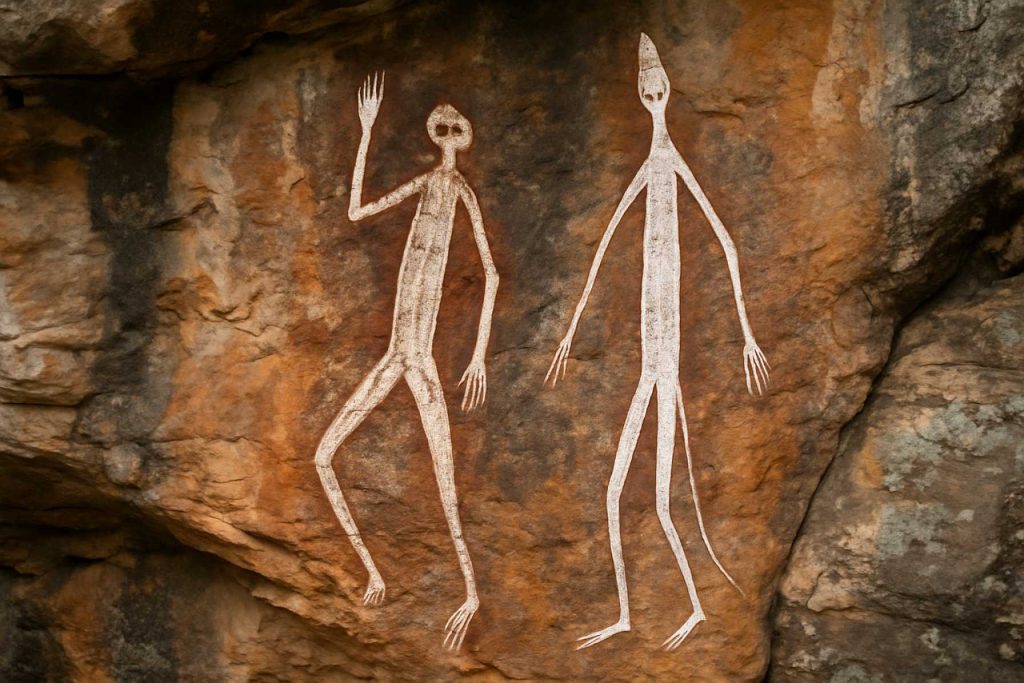
Inside the World of Mimih Spirits: Mysterious Beings of Arnhem Land’s Ancient Rock Art and Lore. Discover Their Secrets, Stories, and Enduring Influence in Aboriginal Mythology.
- Introduction to Mimih Spirits: Origins and Significance
- Geographical Context: Arnhem Land and Its Sacred Sites
- Physical Descriptions and Unique Characteristics
- Mimih Spirits in Aboriginal Oral Traditions
- Role of Mimih Spirits in Creation Myths
- Mimih Spirits and Rock Art: Visual Representations
- Interactions with Humans: Stories of Encounters
- Spiritual and Cultural Functions in Aboriginal Society
- Contemporary Interpretations and Cultural Preservation
- Conclusion: The Enduring Legacy of Mimih Spirits
- Sources & References
Introduction to Mimih Spirits: Origins and Significance
Mimih spirits are enigmatic beings deeply embedded in the mythology of the Aboriginal peoples of northern Australia, particularly among the Kunwinjku, Jawoyn, and other groups of western Arnhem Land. These spirits are renowned for their slender, elongated forms and their association with the rocky escarpments and stone country of the region. According to Aboriginal tradition, the Mimih spirits predate the arrival of humans and are considered some of the earliest ancestral beings, playing a crucial role in shaping the landscape, imparting knowledge, and establishing cultural practices.
The origins of the Mimih spirits are rooted in the Dreaming, or “Dreamtime,” a foundational concept in Aboriginal cosmology that describes the time when ancestral beings created the world and established the laws of existence. Mimihs are believed to inhabit the crevices and caves of Arnhem Land’s sandstone outcrops, emerging only when the environment is calm, as their delicate bodies are said to be easily broken by strong winds. Their presence is often evoked in rock art, where their distinctive elongated forms are depicted in ochre on cave walls, serving as both spiritual symbols and historical records of their significance.
The significance of Mimih spirits extends beyond their mythological origins. They are credited with teaching the first people essential skills such as hunting, cooking, and the use of fire, as well as the creation of tools and weapons. In this way, Mimihs are seen as culture bearers, bridging the gap between the spiritual and human worlds. Their stories are passed down through oral traditions, ceremonies, and artistic expressions, reinforcing social norms and the connection to the land. The Mimihs’ role as intermediaries and teachers underscores their importance in maintaining the continuity of cultural knowledge and identity among the Aboriginal peoples of Arnhem Land.
Today, the legacy of the Mimih spirits is preserved and celebrated through ongoing cultural practices, including storytelling, ceremonial performances, and the creation of contemporary art. Institutions such as the Australian Institute of Aboriginal and Torres Strait Islander Studies play a vital role in documenting and supporting the transmission of these traditions. The enduring presence of Mimih spirits in both ancient and modern contexts highlights their profound influence on the spiritual and cultural landscape of northern Australia, embodying the resilience and creativity of Aboriginal heritage.
Geographical Context: Arnhem Land and Its Sacred Sites
The Mimih spirits are deeply rooted in the cultural and spiritual landscape of Arnhem Land, a vast region in the Northern Territory of Australia. Arnhem Land is recognized for its rugged escarpments, dense woodlands, and extensive river systems, forming a unique environment that has been home to Aboriginal peoples for tens of thousands of years. This region is not only geographically significant but also holds profound spiritual importance, serving as the setting for countless Dreaming stories, including those of the Mimih spirits.
Arnhem Land covers approximately 97,000 square kilometers and is one of the largest Aboriginal reserves in Australia. The area is managed by the traditional owners, the Yolŋu and Bininj peoples, who maintain a strong connection to their ancestral lands and uphold traditional laws and customs. The region’s remoteness and limited access have helped preserve its cultural heritage and sacred sites, many of which are associated with the Mimih spirits. These sites include rock shelters, caves, and escarpments adorned with ancient rock art, some of which depict the slender, elongated forms of the Mimih.
The sacred sites of Arnhem Land are integral to the spiritual beliefs of its Indigenous inhabitants. According to tradition, the Mimih spirits inhabit the rocky outcrops and crevices of the Arnhem Land plateau. These spirits are believed to be the original inhabitants of the land, predating humans, and are credited with teaching the first people essential skills such as hunting, cooking, and the use of fire. The Mimih are said to be extremely fragile and elusive, only emerging from their rocky dwellings at night or when the wind is still, as even a strong breeze could shatter their delicate forms.
Many of the rock art galleries in Arnhem Land, particularly in areas like Kakadu National Park and the stone country around Gunbalanya (Oenpelli), feature depictions of Mimih spirits. These artworks are not merely decorative; they serve as visual records of ancestral beings and are integral to the transmission of cultural knowledge. The preservation and protection of these sacred sites are overseen by organizations such as the Northern Land Council and the Australian Government Department of Climate Change, Energy, the Environment and Water, which work in partnership with traditional owners to ensure the ongoing safeguarding of Arnhem Land’s cultural and natural heritage.
In summary, the geographical context of Arnhem Land—with its dramatic landscapes and abundance of sacred sites—provides the essential backdrop for the mythology of the Mimih spirits. The region’s enduring cultural significance is reflected in the continued reverence for these spirits and the careful stewardship of the land by its traditional custodians.
Physical Descriptions and Unique Characteristics
Mimih spirits are supernatural beings deeply embedded in the mythology of the Aboriginal peoples of northern Australia, particularly among the Kunwinjku and other Bininj groups of western Arnhem Land. Their physical descriptions are both distinctive and evocative, reflecting the unique landscape and cultural context from which these stories arise.
Mimih spirits are most commonly described as extremely tall, slender, and fragile beings. According to traditional accounts, their bodies are so elongated and thin that they can be easily broken by strong winds. This fragility is a defining characteristic, and it is said that Mimih spirits dwell in the crevices and fissures of rocky escarpments, where they are protected from the elements. Their height is often exaggerated in oral traditions, with some stories claiming that Mimih can be as tall as the rock faces themselves, yet so narrow that they can slip through the smallest cracks in the stone.
The Mimih are also noted for their almost ethereal appearance. They are sometimes depicted with elongated limbs and necks, and their movements are described as graceful and otherworldly. In Aboriginal rock art, particularly in the Kakadu and Arnhem Land regions, Mimih figures are often painted with exaggeratedly thin bodies and delicate features, emphasizing their supernatural qualities. These depictions serve not only as artistic expressions but also as visual records of the stories and beliefs held by the local communities.
Another unique characteristic of the Mimih is their association with sound and music. It is believed that the Mimih were the original creators of the didgeridoo (known locally as yidaki), teaching humans how to craft and play this iconic instrument. This connection to music further enhances their mystical status within Aboriginal culture, as the didgeridoo is central to ceremonial life and storytelling.
Mimih spirits are also known for their elusive and secretive nature. They are said to avoid contact with humans, only revealing themselves under special circumstances or to those who show respect for the land and its traditions. Despite their fragility, Mimih are considered powerful beings, capable of both helping and harming people depending on how they are treated. Their knowledge of bush foods, hunting, and survival skills is legendary, and they are sometimes credited with teaching these essential practices to the first people.
The unique physical and behavioral traits of the Mimih spirits underscore their role as both guardians and teachers in Aboriginal mythology, embodying the delicate balance between the natural and supernatural worlds.
Mimih Spirits in Aboriginal Oral Traditions
Mimih spirits occupy a significant place in the oral traditions of the Aboriginal peoples of northern Australia, particularly among the Kunwinjku, Jawoyn, and other groups of western Arnhem Land. These spirits are described as tall, slender, and fragile beings, so delicate that even a strong wind could break them. According to Aboriginal oral histories, the Mimih have inhabited the rocky escarpments and stone country of Arnhem Land since time immemorial, long before the arrival of humans. Their stories are passed down through generations via storytelling, song, and visual art, forming a vital part of the region’s cultural heritage.
In Aboriginal oral traditions, Mimih spirits are often portrayed as the original custodians of knowledge, particularly in relation to hunting, cooking, and the use of fire. It is said that the Mimih taught the first people how to hunt kangaroos and other animals, how to prepare food, and how to use tools and weapons. These teachings are considered foundational to the survival and cultural practices of the local Aboriginal communities. The Mimih are also credited with introducing the didgeridoo, a traditional wind instrument, to humans, further emphasizing their role as transmitters of cultural knowledge.
Mimih spirits are believed to dwell in the crevices and caves of the sandstone escarpments, emerging only at night or when the land is quiet and undisturbed. Encounters with Mimih are described as rare and potentially dangerous, as the spirits are known to be both mischievous and elusive. Some stories warn that Mimih can lure people into their rocky homes, where they may become lost or never return. Despite this, the Mimih are not considered malevolent; rather, they are seen as guardians of the land and its secrets, maintaining a delicate balance between the human and spirit worlds.
The oral traditions surrounding Mimih spirits are closely linked to the landscape of Arnhem Land, with specific sites identified as places of Mimih activity. These stories serve not only as spiritual teachings but also as practical guides for navigating the land and respecting its dangers. The transmission of Mimih stories is governed by strict protocols, with elders and custodians responsible for ensuring their accuracy and appropriate sharing. This oral heritage is recognized as an essential component of the living culture of Aboriginal Australians and is protected under various cultural heritage frameworks, including those overseen by organizations such as the Australian Institute of Aboriginal and Torres Strait Islander Studies.
Role of Mimih Spirits in Creation Myths
Mimih spirits occupy a significant place in the creation myths of the Aboriginal peoples of northern Australia, particularly among the Kunwinjku and other Bininj groups of western Arnhem Land. According to traditional narratives, the Mimih are ancient, supernatural beings who predate humans and played a formative role in shaping the landscape, culture, and knowledge systems of the region. Their stories are deeply embedded in the oral traditions and ceremonial life of these communities.
In creation myths, Mimih spirits are often depicted as the original inhabitants of the land, possessing extraordinary powers and wisdom. They are credited with teaching the first humans essential survival skills, such as hunting, cooking, and the use of fire. The Mimih are also said to have introduced the use of tools and weapons, including the spear and the didgeridoo, which remain central to Aboriginal cultural practices. Through these teachings, the Mimih spirits are seen as culture heroes who bridged the gap between the spiritual and human worlds, ensuring the transmission of knowledge necessary for life in the harsh Australian environment.
The Mimih are described as tall, slender beings who dwell in the rocky escarpments and caves of Arnhem Land. Their association with these dramatic landscapes is not coincidental; many creation stories recount how the Mimih shaped the physical features of the land, carving out gorges, waterholes, and rock shelters. These places are considered sacred, serving as tangible reminders of the Mimih’s creative acts and ongoing spiritual presence. The connection between the Mimih and the land underscores the Aboriginal worldview, which sees the environment as a living repository of ancestral power and history.
Rituals and ceremonies often invoke the Mimih spirits, particularly in the context of initiation rites and the transmission of sacred knowledge. Rock art depicting Mimih figures is widespread throughout Arnhem Land, serving both as a record of their mythological deeds and as a means of maintaining spiritual connections across generations. The preservation and interpretation of these stories and artworks are supported by organizations such as the Australian Institute of Aboriginal and Torres Strait Islander Studies, which works to document and protect Indigenous cultural heritage.
In summary, the Mimih spirits are central to the creation myths of northern Australian Aboriginal peoples, embodying the origins of culture, technology, and the landscape itself. Their enduring presence in story, ceremony, and art reflects their foundational role in shaping both the physical and spiritual worlds of Arnhem Land.
Mimih Spirits and Rock Art: Visual Representations
Mimih spirits occupy a significant place in the mythology and artistic traditions of the Aboriginal peoples of northern Australia, particularly among the Kunwinjku and other Bininj groups of western Arnhem Land. These spirits are often described as tall, thin, and fragile beings who dwell in rocky escarpments and caves. Their visual representation is most famously preserved in the region’s ancient rock art, which serves as both a cultural record and a spiritual testament to their enduring presence.
The rock art depicting Mimih spirits is characterized by elongated, delicate human-like figures, often shown in profile with exaggeratedly thin limbs and torsos. These forms reflect the oral traditions describing Mimih as so slender that a strong wind could break them. The paintings frequently include intricate details such as headdresses, ornaments, and hunting implements, indicating the spirits’ roles as culture bearers who taught humans about hunting, cooking, and social customs. The use of red ochre and other natural pigments in these artworks links the spiritual world to the land itself, reinforcing the deep connection between the people, their ancestors, and the environment.
Mimih rock art is not merely decorative; it is a vital component of Aboriginal law and cosmology. The act of painting these spirits is traditionally governed by strict protocols, with only certain individuals permitted to create or restore such images. This process is often accompanied by ceremonies that reaffirm the community’s relationship with the ancestral beings and the land. The rock shelters and escarpments where Mimih art is found are considered sacred sites, protected and maintained by the custodians of the stories and traditions associated with them.
The significance of Mimih representations in rock art has been recognized by major cultural and heritage organizations. For example, the United Nations Educational, Scientific and Cultural Organization (UNESCO) has listed the rock art sites of Kakadu National Park, which include many Mimih figures, as World Heritage for their outstanding cultural value. The National Museum of Australia and the Australian Institute of Aboriginal and Torres Strait Islander Studies (AIATSIS) also document and interpret these artworks, highlighting their importance in understanding the spiritual and artistic heritage of Australia’s First Peoples.
Through their visual representations in rock art, Mimih spirits continue to play a vital role in the transmission of knowledge, law, and identity among Aboriginal communities, serving as a bridge between the past and present, the seen and unseen.
Interactions with Humans: Stories of Encounters
Mimih spirits occupy a unique place in the mythology of the Aboriginal peoples of northern Australia, particularly among the Kunwinjku and other Bininj groups of western Arnhem Land. These spirits are often described as tall, thin, and fragile beings who dwell in the rocky escarpments and caves of the region. Stories of human encounters with Mimih spirits are central to the oral traditions and cultural teachings of these communities, serving both as cautionary tales and as explanations for certain natural phenomena.
According to Aboriginal lore, Mimih spirits are generally elusive and avoid direct contact with humans. However, numerous stories recount instances where people have encountered Mimih, often while hunting or traveling through remote rocky areas. In many tales, Mimih spirits are portrayed as both helpers and tricksters. They are said to possess deep knowledge of the land, bush foods, and hunting techniques, sometimes imparting this wisdom to humans who show respect and caution. For example, some stories describe how the Mimih taught the first people how to hunt with spears and how to cook certain foods, thus playing a formative role in the development of Aboriginal culture and survival skills.
Despite their potential for benevolence, Mimih spirits are also regarded with a degree of fear. Their extreme fragility—so delicate that even a strong wind could break them—means that they are easily disturbed by human activity. Many stories warn that making loud noises or behaving disrespectfully in Mimih-inhabited areas can provoke their anger. In some accounts, Mimih spirits lure people into their rocky homes, sometimes to teach them, but occasionally to keep them captive. These narratives serve as cautionary lessons about respecting the land and its unseen inhabitants, reinforcing social norms and environmental stewardship.
The stories of Mimih encounters are not only important for their moral and practical lessons but also for their role in ceremonial life. Mimih figures are frequently depicted in rock art and bark paintings, and their stories are recounted in song and dance during rituals. These artistic and performative traditions help to maintain the connection between people, place, and the spiritual world, ensuring that the knowledge of Mimih spirits is passed down through generations. The preservation and interpretation of these stories are supported by organizations such as the Australian Institute of Aboriginal and Torres Strait Islander Studies, which works to document and protect Indigenous cultural heritage.
Spiritual and Cultural Functions in Aboriginal Society
Mimih spirits occupy a significant place in the spiritual and cultural landscape of Aboriginal societies, particularly among the Kunwinjku and other Bininj peoples of western Arnhem Land in Australia’s Northern Territory. These spirits are believed to be ancient, slender beings who dwell in the rocky escarpments and crevices of the region. Their presence is deeply woven into the cosmology, law, and daily life of the communities, serving as both cultural ancestors and cautionary figures.
Spiritually, Mimihs are regarded as the original inhabitants of the land, predating humans and imparting essential knowledge to the first people. According to tradition, they taught Aboriginal people how to hunt, cook, use fire, and perform ceremonial dances and songs. This transmission of knowledge is foundational to the maintenance of cultural practices and the continuity of law (known as law or lore), which governs social behavior, land management, and spiritual observance. The Mimihs’ role as culture-bearers is reflected in rock art, oral histories, and ongoing ceremonial life, reinforcing their status as intermediaries between the human and spiritual realms.
Culturally, Mimih spirits function as guardians of the land and its resources. Their stories are invoked to explain natural phenomena, landscape features, and the origins of certain animals and plants. The Mimihs’ association with specific locations—often dangerous or restricted areas—serves as a means of teaching respect for the environment and reinforcing boundaries within the landscape. For example, children are warned not to wander into rocky outcrops or caves, as these are believed to be Mimih dwellings; such warnings help prevent accidents and preserve sacred sites.
Mimih spirits also play a role in social regulation. Their unpredictable and sometimes mischievous nature is used to caution against breaking taboos or disrespecting cultural protocols. Stories of Mimih abductions or punishments serve as moral lessons, emphasizing the importance of humility, respect, and adherence to tradition. In this way, the Mimihs act as enforcers of social norms and transmitters of collective memory.
The enduring presence of Mimih spirits in art, ceremony, and storytelling highlights their centrality to Aboriginal identity and worldview. Their depiction in rock art—recognized and protected by organizations such as the Australian Government Department of Climate Change, Energy, the Environment and Water—attests to their lasting influence and the ongoing vitality of Aboriginal spiritual traditions. Through the Mimihs, Aboriginal communities maintain a living connection to their ancestral past, the land, and the laws that sustain their societies.
Contemporary Interpretations and Cultural Preservation
The Mimih spirits, central to the mythology of the Aboriginal peoples of northern Australia, particularly the Kunwinjku and other Bininj groups of western Arnhem Land, continue to hold significant cultural resonance in contemporary times. Traditionally depicted as tall, slender beings inhabiting rocky escarpments, Mimih spirits are credited with imparting essential knowledge, such as hunting, cooking, and ceremonial practices, to the first humans. Their stories and imagery remain vital components of Aboriginal cultural identity and heritage.
In the modern era, the interpretation and preservation of Mimih lore have evolved, reflecting both the resilience and adaptability of Aboriginal cultures. Contemporary Aboriginal artists, especially those from the Injalak Arts centre in Gunbalanya, have played a pivotal role in sustaining and reimagining Mimih iconography. Through bark paintings, carvings, and screen prints, artists not only honor ancestral traditions but also communicate the enduring relevance of Mimih spirits to younger generations and broader audiences. These artistic expressions are often showcased in major institutions, such as the Australian Institute of Aboriginal and Torres Strait Islander Studies and the National Gallery of Australia, which are dedicated to the documentation, research, and exhibition of Indigenous Australian cultural heritage.
Cultural preservation efforts extend beyond the visual arts. Community-led initiatives, often supported by organizations like the Australian Institute of Aboriginal and Torres Strait Islander Studies, focus on recording oral histories, language, and ceremonial knowledge associated with the Mimih. These projects aim to safeguard intangible cultural heritage, ensuring that the stories and teachings of the Mimih spirits are transmitted to future generations in their original languages and contexts. Such initiatives are crucial in the face of ongoing challenges, including language loss and the pressures of modernization.
Furthermore, the Mimih spirits have found a place in contemporary educational and cultural programs, both within Aboriginal communities and in broader Australian society. School curricula, museum exhibitions, and cultural festivals increasingly incorporate Mimih narratives, fostering cross-cultural understanding and respect. These efforts are often guided by Aboriginal elders and cultural custodians, who emphasize the importance of maintaining the integrity and sacredness of Mimih stories.
In summary, the contemporary interpretation and preservation of Mimih spirits exemplify the dynamic nature of Aboriginal cultural traditions. Through art, education, and community-driven heritage projects, the legacy of the Mimih continues to inspire, educate, and connect people across generations, ensuring that these ancient spirits remain a living presence in Australia’s cultural landscape.
Conclusion: The Enduring Legacy of Mimih Spirits
The Mimih spirits, central to the mythology of the Aboriginal peoples of northern Australia, particularly the Kunwinjku and other Bininj groups, continue to hold profound cultural significance. Their enduring legacy is evident not only in oral traditions but also in the vibrant rock art that adorns the escarpments of Arnhem Land. These spirits, often depicted as tall, slender beings inhabiting rocky crevices, serve as both guardians and teachers, embodying the deep connection between the land, its people, and the spiritual world.
The stories of the Mimih spirits have been passed down through countless generations, shaping the moral and social frameworks of the communities that revere them. They are credited with imparting essential knowledge about hunting, gathering, and the use of fire, as well as the creation of tools and musical instruments such as the didgeridoo. This transmission of knowledge underscores the Mimih’s role as culture bearers, ensuring the survival and continuity of Aboriginal traditions and practices.
In contemporary times, the legacy of the Mimih spirits is preserved and celebrated through various forms of artistic expression, including painting, sculpture, and performance. The depiction of Mimih figures in rock art, some of which dates back thousands of years, is recognized as a testament to the enduring spiritual and cultural values of the region’s Indigenous peoples. These artworks are not only significant to the communities themselves but are also acknowledged by organizations such as the United Nations Educational, Scientific and Cultural Organization (UNESCO) for their outstanding universal value as part of the world’s cultural heritage.
Furthermore, the Mimih spirits continue to inspire contemporary Aboriginal artists, whose works are exhibited in major institutions and collections, contributing to a broader appreciation and understanding of Indigenous Australian culture. The preservation of Mimih stories and imagery is supported by organizations like the Australian Institute of Aboriginal and Torres Strait Islander Studies (AIATSIS), which plays a crucial role in documenting, researching, and promoting the cultural heritage of Australia’s First Peoples.
Ultimately, the Mimih spirits exemplify the resilience and adaptability of Aboriginal mythology. Their stories remain a living tradition, fostering a sense of identity, continuity, and respect for the land. As custodians of ancient wisdom, the Mimih spirits continue to inspire both Indigenous and non-Indigenous Australians, ensuring that their legacy endures well into the future.
Sources & References
- Australian Institute of Aboriginal and Torres Strait Islander Studies
- Australian Government Department of Climate Change, Energy, the Environment and Water
- United Nations Educational, Scientific and Cultural Organization (UNESCO)
- National Museum of Australia
- Australian Institute of Aboriginal and Torres Strait Islander Studies (AIATSIS)



